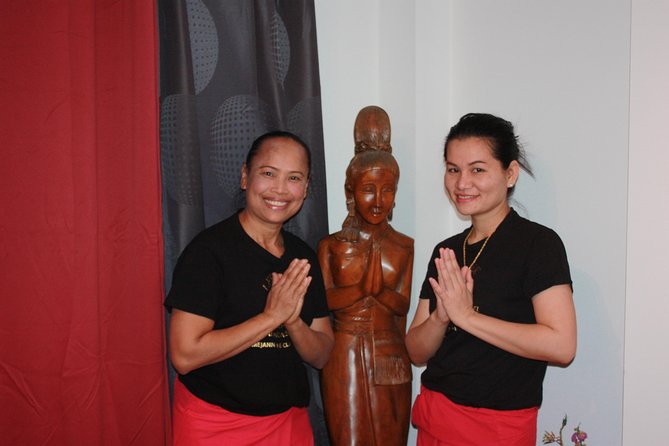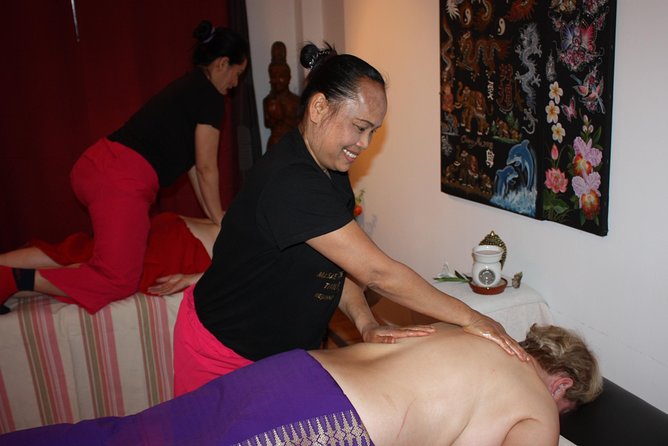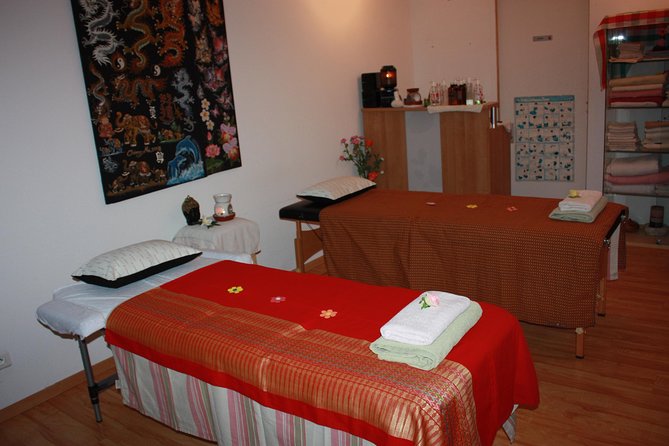Traditional Thai Massage, or "nuad bo-rarn," is not merely a form of relaxation; it’s a comprehensive healing art with roots deeply embedded in the history of Thailand. Developed over millennia, this massage technique incorporates elements of mindfulness and connection, distinguishing it from more conventional therapies. Practitioners use their hands, knees, legs, and feet to move one into a series of yoga-like stretches while also applying muscle compression, joint mobilization, and acupressure. It’s said that the benefits go beyond the physical, fostering spiritual growth and emotional resilience. However, the technique’s true depth is often overshadowed by common misconceptions. What might some of these misconceptions be, and how do they affect the perception of this ancient practice?
Origins of Thai Massage

Thai massage, with its roots deeply embedded in the ancient healing traditions of Ayurveda and traditional Chinese medicine, originated over 2,500 years ago.
It’s a holistic practice that combines physical and energetic aspects, reflecting Thailand’s cultural synthesis of Indian and Chinese influences. Traditional Thai massage involves a series of interactive, flowing movements where practitioners use their hands, knees, legs, and feet to gently move recipients into various yoga-like stretches.
The practice, also known as "nuad bo-rarn" in Thai language, was influenced by Buddhist teachings and was traditionally taught and practiced in temples.
It emphasizes mindfulness, loving-kindness, and the therapeutic connection between the practitioner and the recipient, ensuring a deeply spiritual component in each session.
Health Benefits

Traditional Thai massage offers numerous health benefits that cater to both physical and mental well-being.
Originating from ancient healing traditions, it enhances flexibility, reduces tension, and improves circulation. The technique targets energy lines, promoting balance in the body’s vital energy.
It’s also highly effective in alleviating chronic pain, including back and neck issues, which are common complaints in today’s sedentary lifestyle.
Mentally, this massage technique has been shown to reduce stress and anxiety, fostering a sense of calm and relaxation.
It encourages mindfulness and deep breathing, which are crucial for mental clarity.
Plus, regular sessions contribute to improved sleep patterns, helping individuals rejuvenate and restore their energy, crucial for maintaining an active and healthy lifestyle.
You can also read our reviews of more tours and experiences in France.
Techniques Explained
Several distinct techniques define the practice of traditional Thai massage, each aimed at enhancing physical and mental health through ancient practices. This holistic approach combines various methods to relax the body and invigorate the spirit.
| Technique | Description | Benefits |
|---|---|---|
| Compression | Applying pressure to specific body points | Enhances circulation |
| Stretching | Gentle pulling and stretching of limbs | Improves flexibility |
| Joint Mobilization | Gentle movements of joints in circular motion | Increases joint mobility |
| Acupressure | Targeted pressure on energy lines | Stimulates energy flow |
These techniques collectively work to harmonize the body’s energies, alleviate stress, and promote healing. The practitioner skillfully integrates these into a seamless flow, ensuring a deeply rejuvenating experience.
Preparation Tips

To maximize the benefits of a traditional Thai massage, proper preparation is crucial.
Before delving into this ancient healing art, individuals should consider various steps to ensure an enriching experience.
Here are some key tips:
-
Wear Loose Clothing****: Choose comfortable, breathable fabrics that allow for flexible movement.
-
Avoid Heavy Meals: Eat lightly at least one hour before your session to avoid discomfort.
-
Stay Hydrated: Drinking water beforehand aids muscle relaxation and toxin release.
-
Communicate: Inform your therapist about any specific pain points or injuries to tailor the massage.
These preparations not only respect the cultural practices but also enhance the healing and relaxation potential of the Thai massage experience.
What to Expect
Embarking on the journey of a traditional Thai massage at Sabaï Sabaï brings a unique blend of relaxation and rejuvenation. Guests should expect to be greeted with warm hospitality and a tranquil atmosphere, reflective of Thailand’s rich cultural heritage.
The session starts with a gentle ritual to ease one’s mind and transition from the hustle of daily life into a state of serenity.
During the massage, practitioners use their hands, elbows, knees, and feet to apply pressure along the body’s energy lines and points. This technique not only alleviates muscle tension but also enhances flexibility and stimulates internal organs.
It’s a holistic approach that nurtures both body and spirit, leaving guests feeling profoundly relaxed and energetically balanced.
Common Misconceptions

While many find the traditional Thai massage to be a deeply relaxing and healing experience, there are several misunderstandings about what this practice involves.
This form of massage, rooted in ancient healing traditions, is often shrouded in misconceptions that can skew expectations:
-
It’s purely for relaxation: Thai massage also focuses on therapeutic benefits, enhancing flexibility and circulation.
-
It’s similar to Western massage: Unlike Western styles that often use oils and soft tissue manipulation, Thai massage involves stretching, pressure points, and no oils.
-
It’s comfortable and gentle: Some maneuvers can be quite firm and require active participation.
-
It’s spiritual: While there are spiritual elements, the core is physical and therapeutic wellness.
Understanding these aspects ensures a more appreciative approach to experiencing this cultural practice.
- From Paris: Reims and Champagne Tasting Full-Day Tour
- From Nice: Saint-Tropez and Port Grimaud Day Tour
- Paris: Musée D’orsay Guided Tour With Pre-Reserved Tickets
- From Nice: Verdon Gorge Full-Day Tour
- From Le Havre: D-Day Beaches Shore Trip With Packed Lunch
- From Nice: Provence and Its Medieval Villages Full-Day Tour
Choosing the Right Therapist

Selecting an experienced and skilled therapist is essential when considering a traditional Thai massage, as their expertise significantly influences the effectiveness and enjoyment of the treatment.
It’s crucial to look for practitioners who’ve undergone extensive training in Thailand, where this healing art originated. Authentic Thai massage therapists are typically trained at institutions recognized by the Thai Ministry of Public Health.
These professionals understand the intricate techniques and cultural significance behind the practice, ensuring a genuine and beneficial experience.
When choosing a therapist, don’t hesitate to inquire about their qualifications and years of experience in Thai massage. It’s also beneficial to read reviews or seek recommendations to ensure they’re well-respected within the community.
Aftercare Advice
After receiving a traditional Thai massage, it’s important to follow specific aftercare advice to maximize the benefits of the treatment.
Here’s what you should consider:
-
Stay Hydrated: Drink plenty of water to help flush out toxins that have been released during the massage.
-
Rest: Allow your body some time to relax further and rebalance after the session.
-
Eat Lightly: Opt for a light meal that’s easy to digest; heavy meals can strain your freshly relaxed muscles.
-
Avoid Strenuous Activity: Give your body a break from intense physical activity for the rest of the day to prevent strain and enjoy the massage’s full effect.
These steps help ensure that you retain the therapeutic benefits of a traditional Thai massage.
Worth The Stay
Traditional Thai massage, rooted in ancient wisdom, offers a holistic approach to wellness, blending spiritual and physical healing practices. It’s crucial to choose a knowledgeable therapist and prepare mentally and physically for the session. Embracing this therapy can lead to significant health benefits, including improved flexibility and reduced stress. Aftercare is essential to maximize these benefits. By dispelling common misconceptions, one can fully appreciate the depth and therapeutic potential of this culturally rich practice.
More Tour Reviews in France
- The Secrets of the Puisaye-In the Footsteps of Colette,Potters & Castle Builders
- Walk in the Vineyards of Chablis Grands Crus
- Private Wine Trip to Saint-Emilion Aboard Vintage French Presidential Car
- Paris: Panthéon Private Guided Tour With Entrance Ticket
- Guided Tour of the Estate & Tasting of 4 Wines
- Paris: France Miniature Park Private Tour With Entry Ticket
Not for you? Here's more things to do in France we have recnetly reviewed
- 4 Best Food Tours In France
- 4 Best Full-Day Tours In France
- 6 Best Cruises And Boat Tours In France
- Visit and Tasting, the Secrets of Haut-Armagnac
- Integral Route 15 Km
- Summer Solstice Visits Basilica of Vézelay
- Parc Astérix: Private Transport From Paris + Entrance Ticket
- Bike Ride South of Bordeaux
- Visit of the Château Du Cros and Introduction to Tasting
- Classic Car Rental in Chantilly
- Visit of the Winery and Vertical Tasting
- Let You Transport Safely and Enjoy Our Beautiful Region
